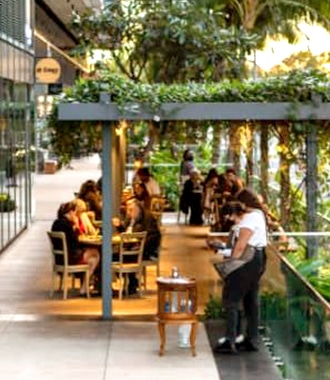A Good City is a Walkable City

Across the country Americans are flocking back to cities and the convenience of well-planned urban neighborhoods.
While the mid-20th century bore witness to the rise of the suburbs and an exodus of people leaving urban life behind, this past decade has shown that many of us have helped turn back the tide and favor city life. As droves of us move back into high rises, walk-ups, and apartments, our urban hubs are changing to reflect our needs and are becoming more efficient by offering more conveniences, all the while utilizing less space. At the cornerstone of our changing urban environment is the concept of walkability. As its name implies, a walkable city is, above all, a convenient city where residents can work, shop, dine, and play—all without relying on a car to get them to their destination. Here at Ward Village, creating a walkable community is at the very fabric of our identity.
So what makes a walkable city so great? As it turns out, the benefits are ten-fold. A recent study conducted by Portland, Oregon-based economist, Joseph Cortright found that cities with a high walkability score actually hold higher property values than non-walkable cities. In his book, Walking the Walk: How Walkability Raises Housing Values in U.S. Cities, Cortright examined the numbers behind 94,000 real estate sales in 15 large US cities. Remarkably, he found that in 13 of the 15 markets, the most walkable cities were indeed tied to higher home values.
“Even in a turbulent economy, we know that walkability adds value to residential property just as additional square footage, bedrooms, bathrooms and other amenities do,” Cortright told GOOD Magazine. “It’s clear that consumers assign a tangible value to the convenience factor of living in more walkable places with access to a variety of destinations.”
The benefits of living in a walkable city extend well beyond adding value of your home. Small businesses located in walkable neighborhoods have actually shown to be more profitable. It all comes down to a simple realization: when you’re walking in your neighborhood, you’re more invested in your neighborhood. You meet new people, eat at new restaurants, and explore new shops. You become involved in your community as you become a part of a community. And if that weren’t enough, people who live in walkable communities have proven to be healthier than their counterparts.
Another study, conducted by the University of Melbourne in Australia, examined the behavior of 1,400 residents who recently moved into a walkable neighborhood. The more retail establishments located near their homes, the more these residents walked. For every shop, it was estimated that neighbors walked around five minutes more per week. And if someone lives near a park, they walked an average of 21 minutes more per week. Doctors have reiterated that the simple act of walking has tremendously positive implications for our health that include stronger bones, weight loss, and lowers the risk of Alzheimer’s, just to name a few. In essence, by simply moving to a walkable neighborhood, you’re doing your health a favor.
At Ward Village, creating an environment that promotes walking to your daily needs is paramount to our design. Through our expansive central plaza, wide sidewalks, and emphasis on placing a wealth of shops and restaurants a stone’s throw from residential towers, we’re reshaping the idea of what a neighborhood can be. At its essence, it means leaving your car keys at home and embracing the power of your own two feet.






